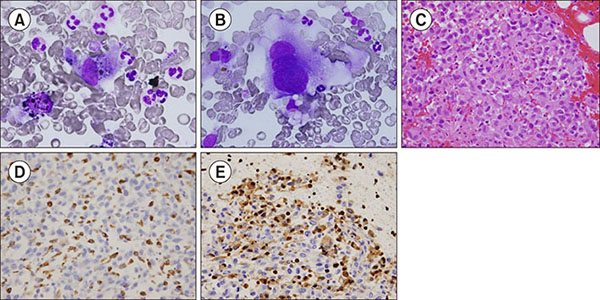
A 76-year-old man developed difficulties in walking due to back pain and visited a hospital. Multiple myeloma was suspected, and he was referred to our hospital. On admission, a peripheral blood test revealed neutrophilia (neutrophils, 17,788/µL) and anemia (hemoglobin, 8.1 g/dL), and contrast-enhanced computed tomography demonstrated lytic bone lesions in the eighth thoracic vertebra, fourth lumbar vertebra, and left caput femoris. A bone marrow smear showed 37.6% neoplastic cells with increased segmented neutrophils and macrophages. The number of plasma cells was not increased. The neoplastic cells were large and pleomorphic; some had basophilic granules and foamy cytoplasm, showing hemophagocytosis (A, B). H&E staining showed diffuse proliferation of neoplastic cells (C). Immunohistochemically, they were positive for histiocytic markers [CD68 (D) and lysozyme (E)] and negative for lymphoid markers (CD3 and CD20), dendritic cell markers (CD21 and CD1a), a myeloid marker (myeloperoxidase), and a mast cell marker (c-kit). These data confirmed the diagnosis of histiocytic sarcoma. The patient received combination chemotherapy with therarubicin, cyclophosphamide, vincristine, and prednisolone. However, he rapidly developed pancytopenia and died of pneumonia. Histiocytic sarcoma is a very rare neoplasm, and bone marrow involvement is uncommon. Therefore, this patient's bone marrow smear images are particularly rare and valuable.




 PDF
PDF ePub
ePub Citation
Citation Print
Print


 XML Download
XML Download